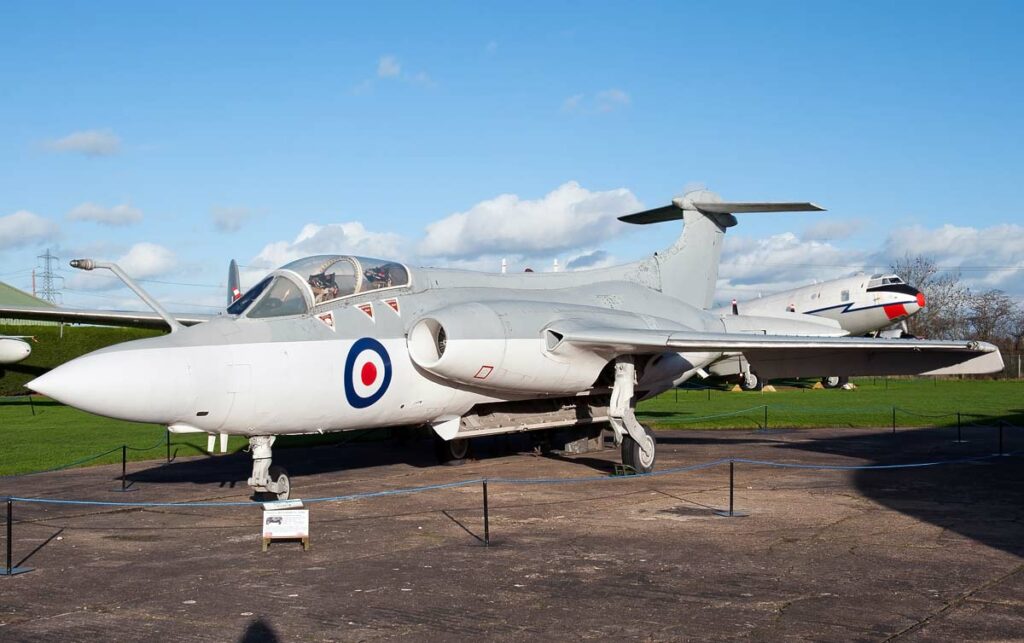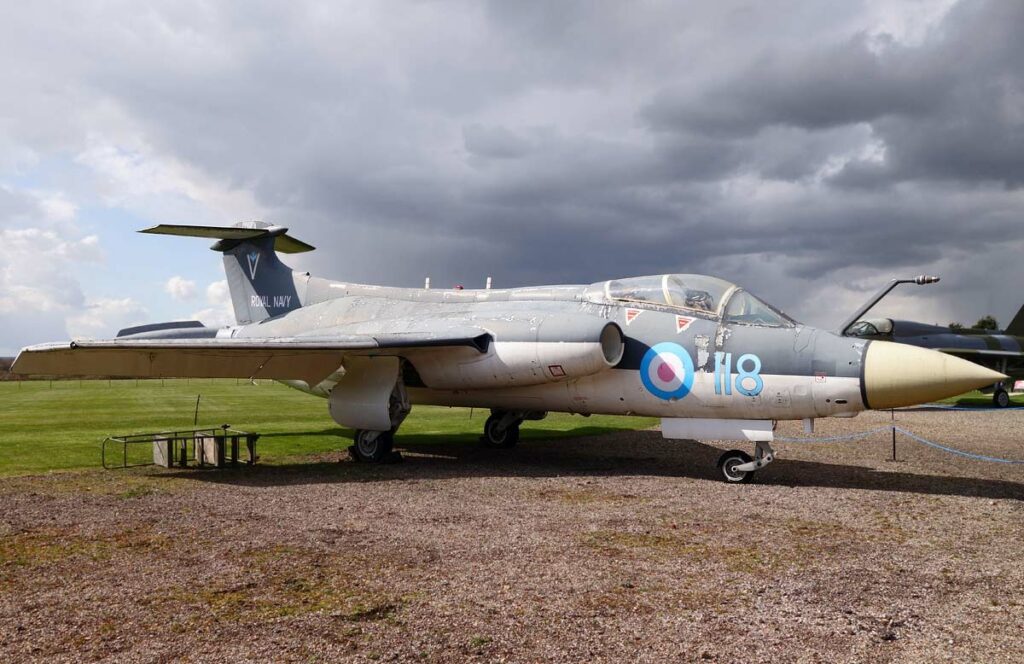The Blackburn Buccaneer, a British twin-engine, carrier-based strike aircraft, excelled in low-level penetration at high speeds.
In Brief
The Blackburn Buccaneer was a British aircraft designed in the late 1950s for the Royal Navy. It was a low-level, carrier-based strike aircraft that featured a twin-engine design, capable of high-speed penetration missions while flying at very low altitudes. The Buccaneer was renowned for its exceptional range, payload capacity, and survivability, thanks to its robust construction and radar cross-section reduction features. It was powered by two Rolls-Royce Spey turbofan engines, which provided a top speed of over Mach 0.85. The aircraft’s unique design included a variable-incidence wing, which improved carrier takeoff performance and low-speed handling. With its first flight in 1958, the Buccaneer served with the Royal Navy and later with the Royal Air Force, demonstrating remarkable versatility and operational effectiveness until its retirement.

History of the Development of the Blackburn Buccaneer:
The Blackburn Buccaneer was developed during a period marked by rapid advancements in military aviation technology and shifting doctrines regarding naval warfare. In the mid-1950s, the Royal Navy identified a need for a new strike aircraft capable of penetrating enemy air defenses at low altitude, delivering nuclear or conventional payloads with high accuracy. This requirement was in response to the evolving threat of the Soviet Navy and the increasing effectiveness of anti-aircraft systems.
The Blackburn Aircraft Company launched the Buccaneer program to meet this demand, with the project officially starting in 1952. The aircraft’s design focused on low-level flight to evade radar detection, incorporating innovations such as a boundary layer control system for improved aerodynamic performance. The Buccaneer S.1, the initial variant, made its maiden flight on April 30, 1958.
While the Buccaneer did not receive a specific NATO nickname, its capabilities and intended role placed it at the forefront of Cold War naval aviation strategy. The aircraft was designed to operate from the Royal Navy’s carriers, providing a versatile and powerful tool for projecting power and defending fleet operations against surface threats.
Design of the Blackburn Buccaneer:
The design of the Blackburn Buccaneer incorporated several key features that contributed to its effectiveness and durability. Its airframe was engineered for high strength, enabling the aircraft to withstand the stresses of high-speed, low-altitude flight. The Buccaneer’s distinctive wing design, with its variable incidence, allowed for better control and stability during takeoff and landing, particularly on aircraft carriers.
The aircraft measured approximately 19.33 meters (63 feet 5 inches) in length, with a wingspan of 13.41 meters (44 feet) and a height of 4.97 meters (16 feet 4 inches). It was equipped with two Rolls-Royce Spey turbofan engines, which not only provided significant thrust but also contributed to its low radar cross-section by being embedded within the wing root.
One of the Buccaneer’s notable design advantages was its internal weapons bay, which reduced drag and preserved the aircraft’s sleek profile for low-level penetration missions. However, this design choice also limited the size and variety of weapons the Buccaneer could carry, compared to external hardpoints. Despite this, the aircraft’s payload capacity and fuel efficiency were exceptional, enabling long-range missions without the need for mid-air refueling.
Performance of the Blackburn Buccaneer:
In terms of performance, the Buccaneer was capable of reaching speeds over Mach 0.85 and had a maximum range of approximately 2,000 nautical miles (3,704 kilometers) without refueling. Its operational ceiling exceeded 40,000 feet (12,192 meters), though its primary domain was much closer to the ground, often flying just a few hundred feet above sea level to avoid radar detection.
The Buccaneer’s engines, the Rolls-Royce Spey Mk.101s, each produced a thrust of 11,100 pounds-force (49.3 kN), facilitating the aircraft’s impressive speed and range. Compared to contemporaries like the A-6 Intruder, the Buccaneer offered similar low-altitude penetration capabilities but distinguished itself through its carrier-based operational flexibility and the unique design features tailored to this role.
Variants of the Blackburn Buccaneer:
The Buccaneer saw several variants throughout its service life, starting with the S.1, which was powered by de Havilland Gyron Junior engines. The more successful S.2 variant featured upgraded Rolls-Royce Spey engines, significantly improving performance. The RAF variants included the S.2B, equipped for conventional bombing and later modified to carry Sea Eagle anti-ship missiles. The South African Air Force also operated a variant, the S.50, which included specific adaptations for their operational requirements.

Military Use and Combat of the Blackburn Buccaneer:
The Buccaneer’s military service was marked by its roles in both the Royal Navy and the Royal Air Force. Initially designed for nuclear strike missions, its role evolved with the changing nature of naval and aerial warfare, taking part in conventional strike missions and reconnaissance operations. Notably, the Buccaneer saw combat during the 1991 Gulf War, where it was used for laser designation for RAF Tornado jets, proving its adaptability and effectiveness in modern conflict.
The Buccaneer competed with aircraft like the American A-6 Intruder, offering similar capabilities but with distinct operational strategies. Its sale to South Africa marked its international service, where it performed well under different conditions. The Buccaneer was eventually retired in the 1990s, replaced by more modern aircraft capable of fulfilling its roles with advanced technology.
The Blackburn Buccaneer stands as a testament to the ingenuity and foresight of British aerospace design. Its development and service spanned the Cold War, adapting to the evolving demands of modern warfare. Despite its retirement, the Buccaneer’s legacy in naval and air force history remains significant, highlighting the importance of versatility, reliability, and performance in military aviation.
Back to the Fighter Jet section.